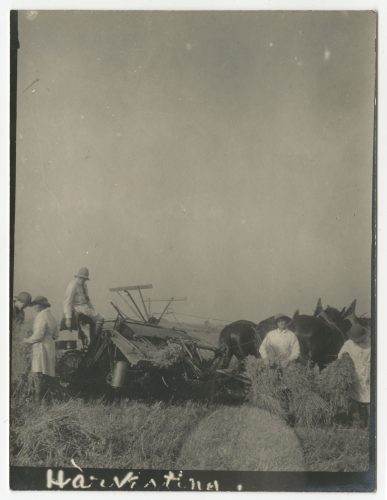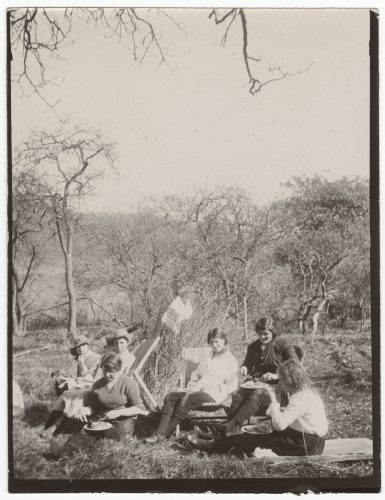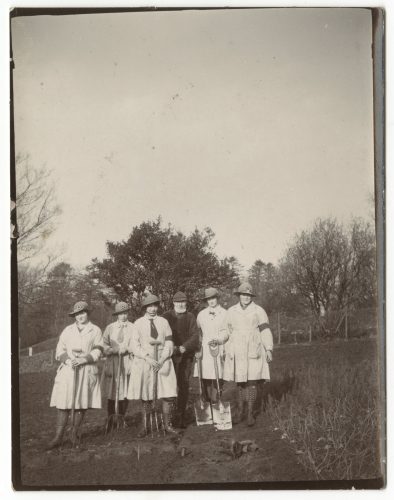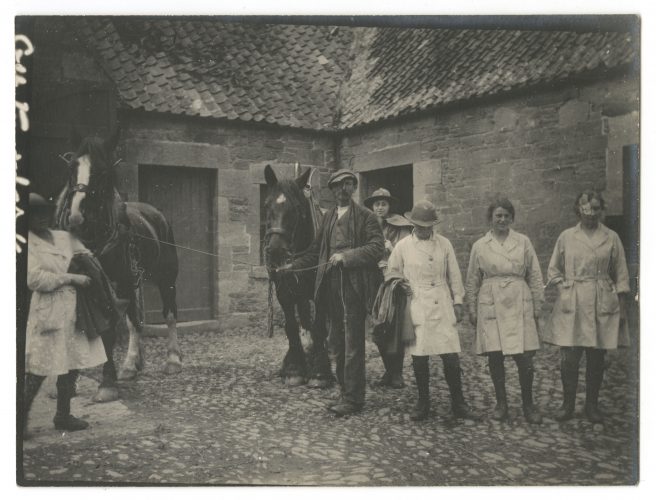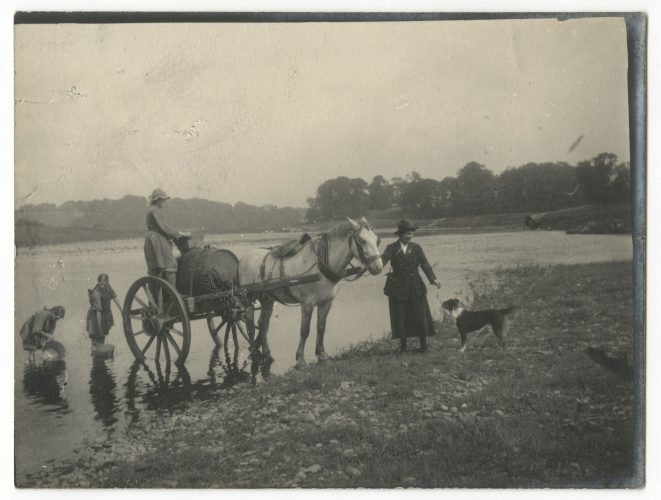Photograph of Women’s Land Army, about 1917-19
Reference: ZBC 123, 126, 128, 131, 132
Suggested age groups: KS1, KS2, KS3, KS4, lifelong learners
Subject areas: History, Literacy, Geography, Art & Design
CONTEXT
At the beginning of the war Britain imported about 60% of its food from abroad.
Conscription meant that men between the ages of 18 and 41 had to join the army from 1916. Farmers and other food producers could be excused from service (exempt), but they had to make their case at Military Service Tribunals.
On 1 Feb 1917 Germany declared unrestricted submarine warfare. This meant that they would bomb any ships from enemy countries; not just military vessels.
The Board of Agriculture established The Women’s Land Army in January 1917 under Muriel Talbot. In March 1917 the Women’s Land Army ran a campaign to recruit women to work on farms and forestry. Over 23,000 women worked for the Land Army, which was a civilian organisation (in spite of the name!). The Women’s Land Army was disbanded in November 1919.
ACTIVITIES
ACTIVITY 1
Background
Conscription meant that men between the ages of 18 and 41 had to join the army from 1916. Farmers and other food producers could be excused from service (exempt), but they had to make their case at Military Service Tribunals.
On 1 Feb 1917 Germany declared unrestricted submarine warfare. This meant that they would bomb any ships from enemy countries; not just military vessels.
SEE
See: What was conscription?
See: Who had to join the army due to conscription?
See: When was conscription introduced?
See: Who could be excused from service?
See: Where did those hoping to be exempt from conscription have to make their case?
See: What did unrestricted submarine warfare mean?
THINK
Think: Why do you think farmers and other food producers could be excused from service?
Think: Do you think people other than farmers and food producers tried to be excused from service?
Think: What other reasons might people have wanted to have been excused from service?
Think: What were conscientious objectors?
Think: What impact do you think unrestricted submarine warfare had on Britain’s access to food and goods?
DO
Do: Research the different reasons that men applied to the Military Service Tribunal for exemption from service.
Do: Create a diagram showing different groups of people and their reasons for asking for exemption.
Do: Create a diagram showing the different types of exemptions that men could apply for.
Do: Recreate a Military Service Tribunal hearing. This could include several different people from different groups asking to be exempt for a range of different reasons. Decide which of the three, if any, exemptions that you would grant each person.
Do: Create a political cartoon showing British attitudes towards conscription.
Resources
ACTIVITY 2
Background
At the beginning of the war Britain imported about 60% of its food from abroad.
The Board of Agriculture established the Women’s Land Army in January 1917 under Muriel Talbot. In March 1917 the Women’s Land Army ran a campaign to recruit women to work on farms and forestry. Over 23,000 women worked for the Land Army, which was a civilian organisation (in spite of the name!). The Women’s Land Army was disbanded in November 1919.
SEE
See: How much of its food did Britain import from abroad?
See: When was the Women’s Land Army established?
See: Who established the Women’s Land Army?
See: When was the Women’s Land Army disbanded?
THINK
Think: Why could Britain no longer import its food?
Think: Why was the Women’s Land Army needed?
Think: What were the aims of the Women’s Land Army?
Think: What types of roles did the Women’s Land Army do?
Think: Why do you think it was called the Women’s Land Army despite being a civilian organisation?
DO
Do: Design a Women’s Land Army recruitment poster to recruit women to work in agriculture and forestry.
Do: Create a map showing where Britain had imported food from at the beginning of the war.
Do: Research the different roles that the Women’s Land Army covered. Write a job description profile for some of these roles. Think about the key duties, skills and experience needed for these different roles.
Do: Think about the job profiles you have created. Discuss how the duties, skills and experience match the pre-war perceptions of women in Britain.
Do: Imagine you are one of the Land Girls shown in the photographs. Write a diary entry about your experience. Think about what you have seen, what you have done, how you feel about it, the circumstances that caused you to join the Women’s Land Army.
Resources
https://www.womenslandarmy.co.uk/world-war-one/
https://www.womenslandarmy.co.uk/first-world-war-womens-land-army/recruitment/
https://www.nfuonline.com/the-few-that-fed-the-many-ww1-report/
https://www.iwm.org.uk/history/the-womens-land-army-in-pictures
http://ww1centenary.oucs.ox.ac.uk/unconventionalsoldiers/the-land-girls-of-the-first-world-war/
OTHER ONLINE RESOURCES
BBC Bitesize website, page about women’s war work (including animation and photographs of different sorts of work): https://www.bbc.co.uk/bitesize/topics/zqhyb9q/articles/zj8my9q
Women’s Land Army website, page about First World War: https://www.womenslandarmy.co.uk/world-war-one/
Women’s Land Army website, page with First World War timeline: https://www.womenslandarmy.co.uk/first-world-war-womens-land-army/timeline-1917-1919/
Imperial War Museum website, page with pictures of Women’s Land Army: https://www.iwm.org.uk/history/the-womens-land-army-in-pictures
World War 1 Centenary website (Oxford University), page about Land Girls: http://ww1centenary.oucs.ox.ac.uk/unconventionalsoldiers/the-land-girls-of-the-first-world-war/
Spartacus Educational website, page about Women’s Land Army: https://spartacus-educational.com/Wland.htm
BBC Bitesize website, page about political impact of women’s war work after the war: https://www.bbc.co.uk/bitesize/guides/zx9887h/revision/4
National Farmers’ Union website, page about food production during WW1: https://www.nfuonline.com/the-few-that-fed-the-many-ww1-report/
Peace Pledge Union website, page about Military Service Tribunals: https://menwhosaidno.org/context/context_tribunalsintro.html


